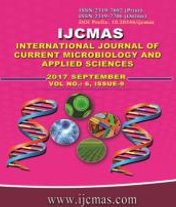


 National Academy of Agricultural Sciences (NAAS)
National Academy of Agricultural Sciences (NAAS)

|
PRINT ISSN : 2319-7692
Online ISSN : 2319-7706 Issues : 12 per year Publisher : Excellent Publishers Email : editorijcmas@gmail.com / submit@ijcmas.com Editor-in-chief: Dr.M.Prakash Index Copernicus ICV 2018: 95.39 NAAS RATING 2020: 5.38 |
The compatibility of indigenous Trichoderma harzianum (KBN-29) with a few foliar fertilizers i.e. muriate of potash (MoP), urea and zinc sulphate was studied under in vitro conditions. The recommended doses of fertilizers (1 and 2% w/v) were tested using solid (PDA) as well as liquid (PDB) media. When these fertilizers were tested individually on solid medium, the antagonist could produce 8.5, 6.9 and 2.6 cm diameter colony in presence of MoP, urea and zinc sulphate, respectively, which indicated, that zinc sulphate as the least compatible when compared to fertilizers. Similarly, in liquid medium, the antagonist could produce 0.76, 0.63 and 0.53 g biomass as compared to untreated control (0.85 g) that showed the similar trend. When the combination of all three fertilizers was tested in solid medium, T. harzianum could develop the colony of 1.4 to 3.4 cm diameter which is significantly less as compared to control (8.7 cm). In case of liquid medium the combination of fertilizers exhibited the similar pattern where the antagonist yielded lesser biomass (0.20 to 0.21 g) compared to control (0.89 g). The study revealed that MoP and urea are compatible with the antagonist, however zinc sulphate was found to be the least compatible.
 |
 |
 |
 |
 |